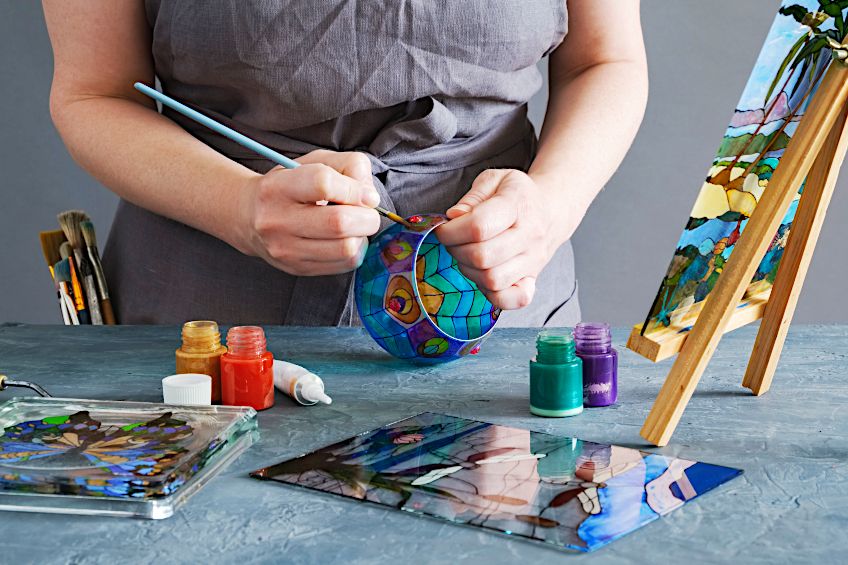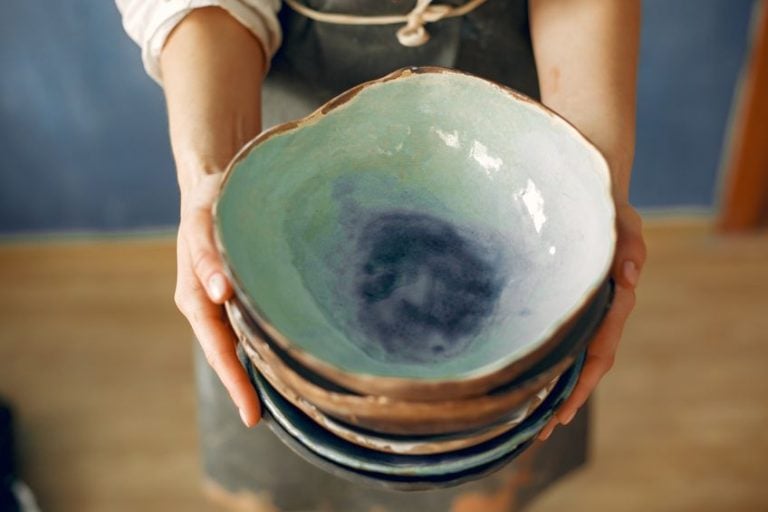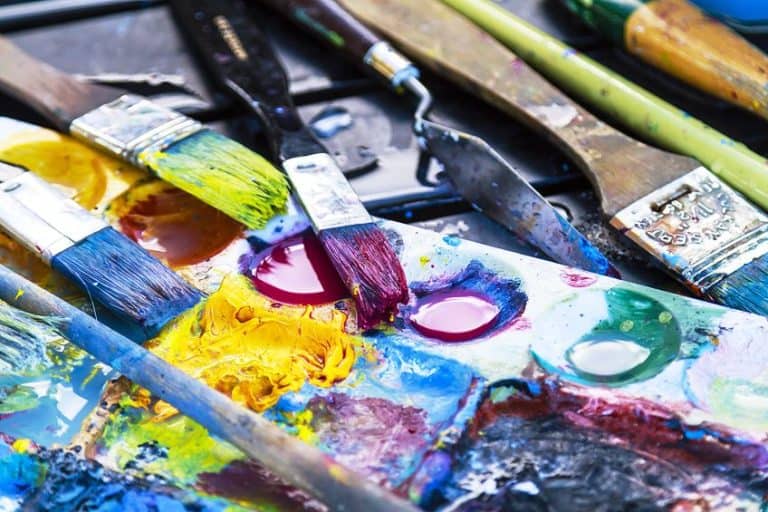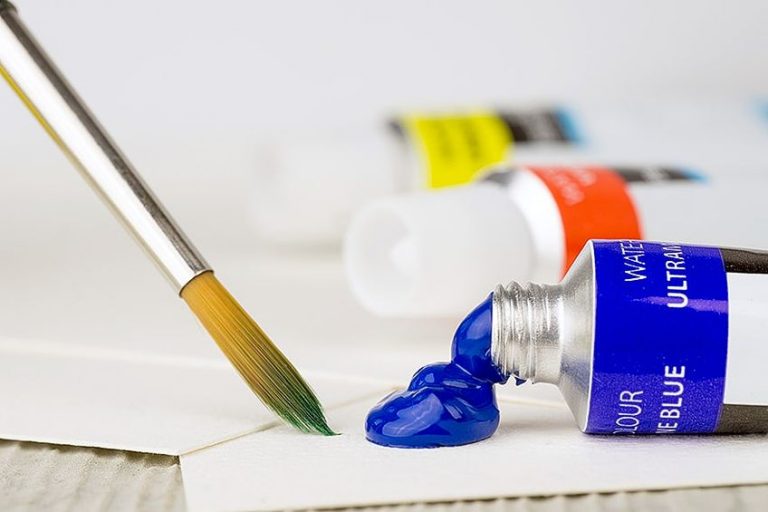Acrylic Paint on Glass – A Guide to Painting Glass With Acrylic Paint
Acrylic paint is probably best known for its versatility as it can be used on a wide variety of surfaces with ease, but can you use acrylic paint on glass? With a bit of preparation, you can easily use acrylic on even the smoothest surfaces like glass. Acrylic does tend to work best on more porous surfaces and can be prone to peeling on smoother ones, but in this article, we will guide you through choosing the right acrylic paint for glass and explain how to paint glass as well as how to seal acrylic paint on glass.
Table of Contents
Can You Use Acrylic Paint on Glass?
Acrylics are durable, water-resistant, easy to clean, and usually non-toxic. These qualities make acrylic paint a very attractive choice for both beginners and experienced artists using any medium you can think of, including glass. You can definitely use acrylic paint on glass but it will not be as easy as using a canvas. When you are painting glass with acrylic paint, you should try to use acrylics that clearly state they work well on glass, such as acrylic enamel paint for glass. Even when using these more specialized acrylics you will face a few challenges that will need to be overcome before you can continue.

The Challenges of Using Acrylic Paint on Glass
There are a few challenges you will encounter when you are painting glass with acrylic paint. Acrylic paints work better on porous surfaces so they can be tricky to apply on glass surfaces unless you use a primer. Without a primer, your paint will tend to slip loosely around the glass and not adhere very easily.
Alternatively, you could lightly sand down the glass to rough up the surface of the glass and help the paint adhere to the glass more readily.
Regardless of whether you sand the glass or use a primer, you will have to seal your paint onto the glass with a sealant or varnish to help prolong its lifespan and prevent it from being damaged over time. Another challenge you might face when using acrylic paint on glass is that acrylic paint is not 100% food safe. You should make sure to use acrylic paint only on the outside of glass objects intended for use with food or drink unless it clearly states that it is food safe.
How to Find the Best Acrylic Paint for Glass
You will need to consider multiple different factors when deciding on what kind of paint to use on glass. Not every acrylic paint available on the market is suitable for glass. Do you need your paint to last as long as possible or do you need it to be food-safe? Enamel-based acrylic paints are the best overall option for using acrylic on glass because they are durable and do not require any priming, but they are not food safe. Read on below to learn how to choose the right paints for your needs, however, always be sure to always read the label if you are unsure.

Product Quality
A brand can claim to be very high-quality but if there are not many consistent or positive reviews it would be best to steer away from them, even if they claim to have premium quality acrylics for glass. Rather opt for a reputable brand with a good, consistent reputation for delivering high-quality products to their customers.
Ideally, you could even choose a brand that offers a money-back guarantee to their customers if they are not satisfied with the product.
Opacity
One of the biggest and most important factors to consider when buying acrylic paint for glass is the opacity of the paint. Opacity refers to how solid the color appears and whether or not it could be considered transparent or not. Opacity is particularly important when it comes to using acrylic paint on glass because opaque paints will stop all light from passing through the glass while less opaque paints will allow tinted light to shine through. Whether you use opaque or transparent paint will depend on your preferences and what you prefer for your project.

Lightfastness
Sometimes, when paint is exposed to sunlight the colors will begin to fade away, a paint that resists fading when exposed to sunlight is considered lightfast. A lightfast paint will be UV and fade resistance and maintain its pigment over time. There are different levels of lightfastness ranging from one to four, with one and two being the highest level of lightfastness.
Craft and student-grade paints don’t usually mention the lightfastness but artist-grade paints such as Liquitex will.
Consistency
If you want your paint to be opaque on the glass to create distinct lines and patterns you will need thick-bodied paint. On the other hand, if you want to create a stained-glass effect on the paint you will need a more fluid consistency in your acrylic. Regardless of which consistency you primarily use, you shouldn’t mix paints of two different consistencies.
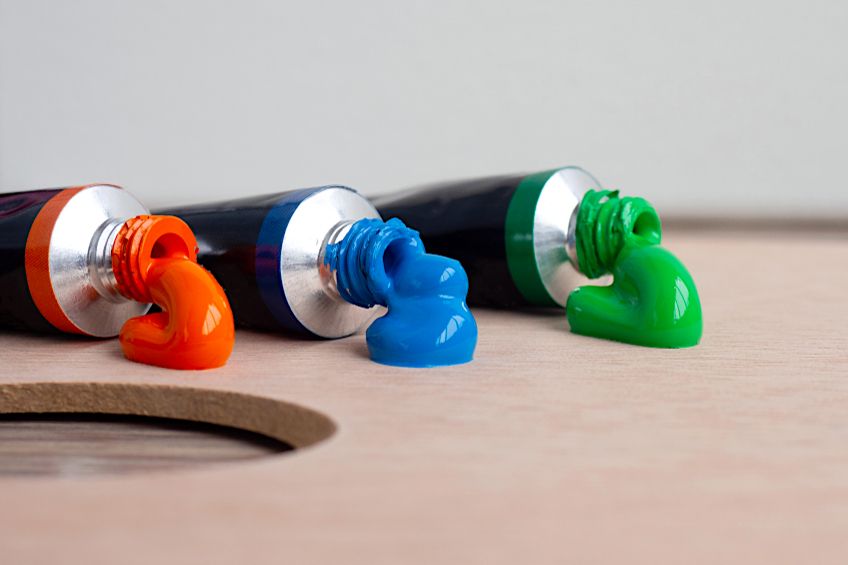
This will result in an inconsistent painting. You can easily test how thick or thin paint is by comparing small amounts of paint next to one another. You might find that fluid paint is easier to use on glass, but thicker paint will be opaquer. The consistency you choose will depend on how you are planning to have your project turn out. Whether you want to thicken or thin your paint you should use the relevant acrylic medium. Don’t use water to thin your acrylic paint and don’t try to thicken your paint using flour or cornstarch.
Drying Time
You will want to choose paint that dries quite quickly. Most acrylic paints are fast drying and should be dry to the touch within 10 or so minutes. Some brands can take longer, however, and you should pay close attention to this because it can affect how long your project will take to complete.
If you want to layer your paints you will want something that dries fairly quickly so that you don’t spend an hour waiting in between each layer.
Finish
Once the paint dries it will have a distinct look and feel. When we refer to the finish of the paint, we are talking about the look and feel of the paint once it has dried. There are many different finishes available to choose between when purchasing a paint to use on glass. Some of the finishes available include gloss, matte and frosted finishes. Each finish will provide a different effect on your final piece.

Many artists will lean towards a frosted or matte finish when choosing an acrylic paint to use on glass, as glossy paint can be too reflective. Some artists, however, prefer to use glossy paint because it can provide a thick, opaque coating on the surface of the glass with ease. The finish you choose for your paint will depend on your own preferences and how you would like your final piece to look.
What Type of Paint to Use With Glass
Acrylic enamel paints are the best acrylic paints available for use on glass because they have been specially developed for ease of use on smooth surfaces. Many acrylic enamel paint for glass options are non-hazardous and can be used for other projects too. We suggest trying out these acrylic enamels paints by the brand Colorful. They are tough, durable, low-odor, and come in a variety of colors. Be sure to make sure that the acrylic enamel you choose is food safe and non-toxic if you plan on using it on any kind of glassware that comes into contact with food or drink.
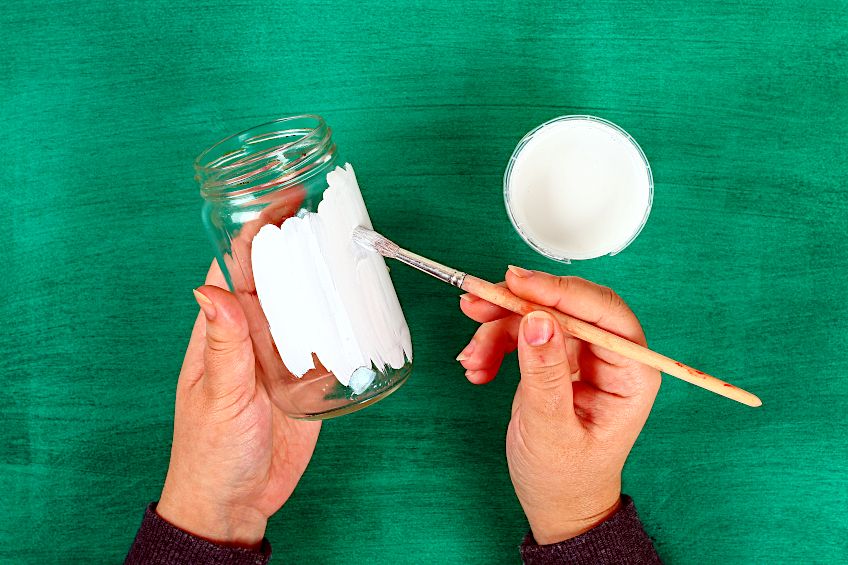
If you don’t want to use acrylic enamel paint you could easily switch it out for acrylic that states it is suitable for use on glass, although you may want to consider priming the glass surface with gesso or a primer before you begin painting. These Apple Barrel acrylic paints are suitable for use on glass.
Another choice is to use a bake-on acrylic paint for glass. Bake-on acrylics will not require a primer as much as normal acrylic for glass. You will need an oven to bake these specialized acrylics according to the instructions of the manufacturer. Further in the article, we provide a general guideline to follow when baking your bake-on acrylics on glass. These bake-on acrylics by FolkArt are a great and reliable choice to try out.
Materials Needed for Painting on Glass
You will need a few different materials when trying to successfully paint on glass with acrylic. Firstly, you will need a piece of glass to paint on. You could pick a piece of glassware, a decorative item, or a flat glass panel. You will also need some rubbing alcohol and cotton pads to clean the surface of the glass before you can begin.
Once you have cleaned your glass, you will need to lightly sand it down and/or add a layer of primer to prepare the surface for proper adhesion. This means that you will need to choose a suitable primer as well as 150 to 180 grit sandpaper. If you choose a suitable paint, which we go into more detail about further in the article, it will not be as necessary to have primer or sandpaper. However, we do suggest that you sand the surface and use a primer to ensure the optimal outcome of your project.
If you plan on painting glass the most important thing you will need is suitable acrylic paint. Try to choose a paint that specifically works on glass surfaces.
You can look at the label to find out this information. Earlier in the article, we went into more detail about how to choose the best acrylic paint for use on glass. Keep in mind that you will want something that has good adherence and is quite durable. Ideally, the best paint to choose will be acrylic enamel paint. Just be sure that no matter what kind of paint you have chosen, you have made sure that it is food safe if it will come into contact with any food or liquid.
If you want to thin down the consistency of your acrylic paint, you could use an acrylic medium to do this successfully. Do not use water to thin down your paint because it breaks down the binder in acrylic and will prevent adhesion. Glass is also non-porous so the water will sit on the glass and not be absorbed.

You will need at least one paintbrush to be able to apply the paint to your glass. It would be ideal to have a range of paintbrushes of different shapes and sizes. Different paintbrushes make it easier for you to achieve different effects or techniques on your glass surface. You could also optionally use stencils to create different patterns and designs with ease.
Finally, you will need a varnish or some kind of sealant to help protect your painting over time. Sealants and varnishes will prolong the lifespan of your painting. Make sure that you use a sealant that is food safe if you plan on using objects that will come into contact with food or liquid. Alternatively, if you are using a bake-on paint that needs to be sealed through baking in an oven then you will need an oven that can heat to the temperature specified by the paint manufacturer.
How to Paint Glass With Acrylic Paint
There are different ways you can approach painting on glass with acrylic. Just like we mentioned above, you could either paint freehand or with a stencil design. We are now going into detail about how to go about painting your first acrylic piece on glass, below are the important steps you will take to get started with this new painting experience.

- A tarp or old newspapers
- Paper towels or rags
- Disposable gloves
- Soapy water
- Rubbing alcohol, isopropyl alcohol, or vinegar
- Your choice of acrylic glass paint
- Paintbrushes
- A glass surface of choice
- Tape (optional)
- Primer or gesso (optional)
- Acrylic medium (optional)
- Sandpaper (optional)
Preparing the Glass, Workspace, and Paints
The first step when using acrylic paint on glass is to make sure that the surface is properly prepared. Put on some disposable gloves to ensure that you don’t leave fingerprints or skin oils on the surface of the glass while you work. Wash the glass surface down using soapy water and then allow it to air dry before wiping it down with rubbing alcohol, isopropyl alcohol, or vinegar and allowing it to air dry once again.
Tape up any areas that you do not want to paint. For example, if you are painting a glass that you will drink from then you should tape off the edges that will come into contact with your mouth if you are not using food-safe acrylic. Having paint over areas where you are drinking from directly can also cause the paint to chip or peel away more quickly.

You can now lightly sand the surface of the glass to start preparing it for painting (optional). Sanding the surface creates a toothy texture that can help paint adhere to the surface of the glass more readily. Make sure that you properly dust down the glass surface once you have finished sanding the area.
You can add a thin, even layer of primer or gesso to primer the surface further (optional). If you are using acrylic enamel paint you must make sure that you use an enamel-based primer. If you choose to prime your glass surface using gesso, keep in mind that gesso will make your paint appear more opaque once dried.
You do not need to coat or sand the whole surface of your glass piece, only the places where you plan on painting.
Remember that many acrylics, including acrylic enamel paint, are specifically formulated for use on glass and will not need a primer to adhere properly. It is a good idea to always prime a surface before painting since it will never hurt and can instead only prolong the lifespan of your piece.
Place down your tarp or newspaper so that you do not have to worry about creating a mess while you work and then begin mixing and preparing your acrylic glass paint. If you are thinning down your paints using an acrylic medium, now is the time to do so. If you are using a bake-on paint, you must make sure that you are using an acrylic medium that is also oven-safe. Now is also the time to mix your colors if you plan on doing so.
Painting the Glass
Now that you have prepared your workspace, paints, and glass surface for painting it is finally time to get started. Take your brushes and start painting using a single color. It helps to use thin, even strokes and multiple layers rather than applying thick strokes right from the beginning. Try to paint towards yourself from farther away rather than moving the brush away from you with each stroke. This allows you more control over your strokes while painting.
Make sure that you properly clean your brushes before changing to a different color. For normal acrylics, you will just need water to clean any paint off of your brushes but if you are using acrylic enamel paint you may find that you will need paint thinner.
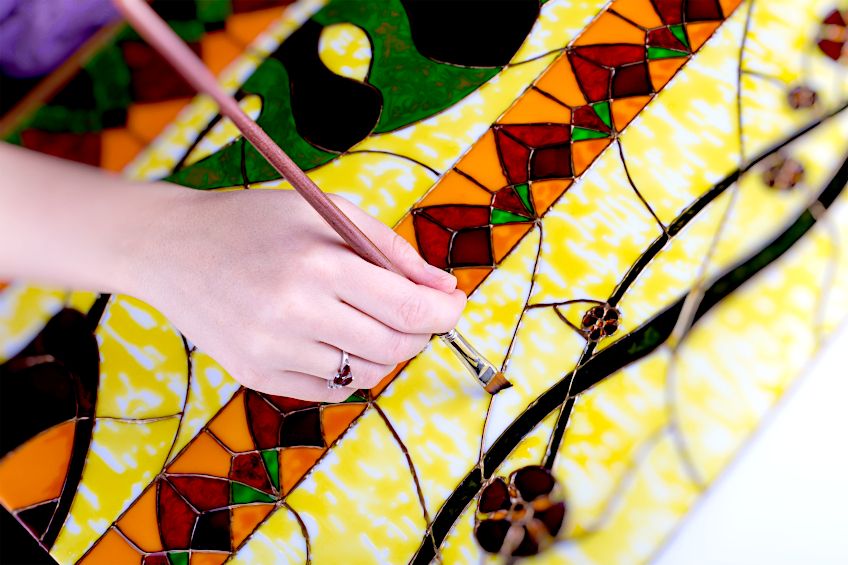
Switch over to your other colors and continue painting as desired. Try not to blend any wet paints while you are working. Try to wait for each color to dry properly before you continue with the next color. The paints can take up to an hour or so to dry but it is worth it to wait. This technique helps create nice, clean blocks of color.
If you make any mistakes while you work, you can use acetone/rubbing alcohol-soaked cotton buds to fix them. You can use this to rub out any small mistakes or splotches. Once you have painted your first layers and cleaned up any mistakes, you can paint a second coat to create more intense, opaque colors on the surface of the glass. It might have seemed opaque enough when it was wet, but acrylic paints often dry to appear lighter.
A second coat can help you to achieve a color closer to the one that you expected.
Drying the Paint
Once you have completed your designs and added as many layers as you like, you will need to give it time to properly dry and cure. All paints have different drying times but most acrylics should be dry to the touch within an hour. To help the paint dry as fast as possible it is best to leave it out in a warm, dry, sunny area where it will not be disturbed. You can use a hairdryer on the lowest setting to dry the paint faster but you must make sure that you do not hold it too close and distort the wet paint.

How to Seal Acrylic Paint on Glass
While acrylic paint will stick to glass if you have followed these steps, you can prolong the lifespan of your piece by sealing it further. There are two main ways you can go about sealing and protecting your acrylic paint on glass. The first option is to apply a coating of transparent sealant and the second option is to use a bake-on paint and then cure and seal it in an oven. Sealing the acrylic protects the paint from cracking, peeling, fading, or yellowing.
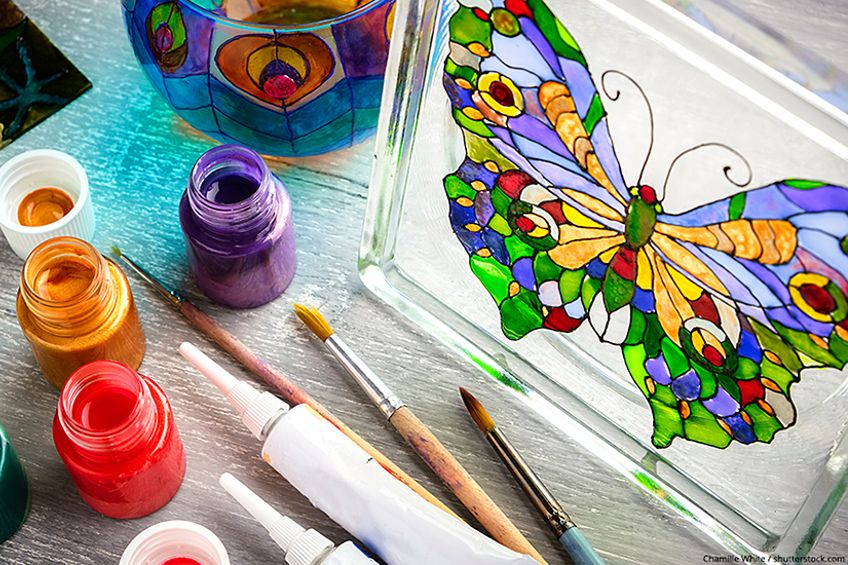
Make sure that you read the instructions on the sealant or varnish that you choose because you will need to know how long you have to wait before you can start sealing your painting, as well as how long you should wait between applying the next layer of sealant/varnish. If you are using a bake-on sealant, you should make sure that you read the instructions and use the temperatures and times outlined within. If you want to be extra safe you can use a bake-on paint and still apply a sealant/varnish afterward. This will ensure the longevity of your piece going forward.
Keep in mind that sealants are best suited for use on decorative items but are usually not food-safe. Oven baking tends to be the preferred method for items that will come into contact with food or drink.
Baking the Paint
If you have used a bake-on acrylic paint then you can place it in the oven to cure and seal it. Do not place normal acrylic paint into an oven since it is a fire hazard. Once your bake-on paint has dried for at least 24 hours or according to the manufacturer’s instructions you can follow the steps below to start baking your acrylic paint.
- Place your glass item onto the oven rack while the oven is still switched off.
- Heat the oven to 350 degrees or according to the product’s instructions.
- Once the oven reaches the appropriate temperature, set a timer for 30 minutes.
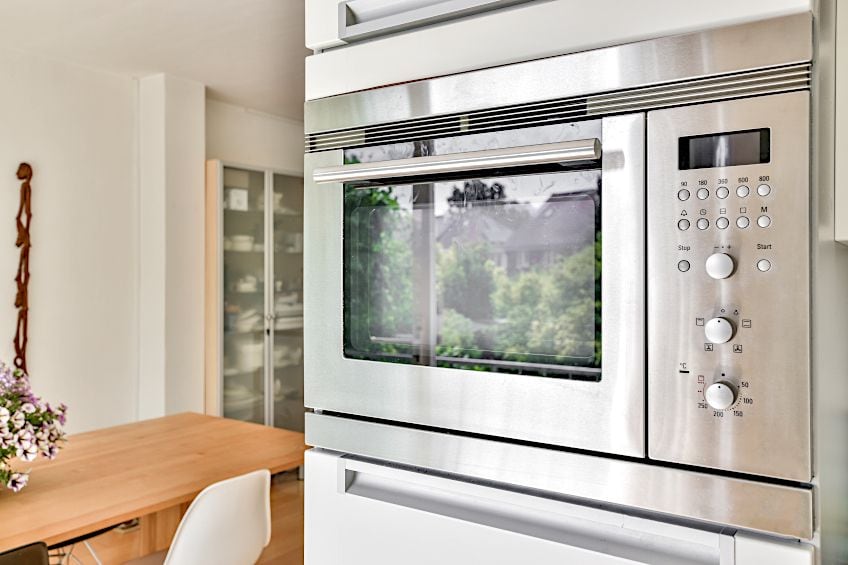
- Once the timer is completed, turn the oven off and leave the glass inside until the oven has completely cooled before removing it.
- Wait at least three days before you wash your piece. This gives it time to properly settle. Remember to always wash your acrylic paint on glass by hand.
How to Apply a Transparent Acrylic Paint Sealant
There are two kinds of sealants that you can apply onto your glass surface, namely, they are spray-on sealants and sealants that you can apply using a brush. If you are sealing a decorative object, you can use whatever sealant you prefer.
If it is an object that will come into contact with food, you must make sure that you use a sealant that is food safe.
Spray-on Transparent Acrylic Paint Sealant
Many people prefer using a spray-on sealant because it does not provide as much contact with the glass, which allows for a nice, even finish. Below we outline the basic steps to get started with sealing your glass piece using a spray-on sealant.
- Set up your work area in a well-ventilated room. Place down a tarp or some old newspapers and place your glass object down on top of them.

- Spray the glass piece with sealant using short, even bursts across the surface. Do not focus too hard on a specific area or point on the glass, this will help you achieve an even finish.
- Allow the first layer of sealant to dry for around 15-20 minutes before applying the next layers by repeating the previous steps.
Brush-on Transparent Acrylic Paint Sealant
If you are using a brush-on sealant you will find that the technique is a bit more tedious. You will have brushes to clean up afterward and will have to be careful to not create brushstrokes on the surface of your piece.
- Work in a well-ventilated room and place down a tarp or some old newspapers.
- Use a paintbrush to coat the glass with a thin, even layer of sealant. Watch to ensure that you are not leaving behind visible brushstrokes.
- Leave the sealant to dry for about an hour before applying additional coats.
- Once you are satisfied with the number of coats allow the piece to dry for a final 24 hours once again.
Techniques, Tips, and Tricks for Using Acrylic Paint on Glass
- An artist’s flat sable, synthetic or bristle brush are all very good brush choices when using acrylic paint on glass. These brushes are designed to hold more acrylic than many other kinds of brushes available on the market.
- Try to make sure that the acrylic paint you choose is specifically suitable for use on glass. The ideal choice of paint to use is acrylic enamel paint.
- Try to find paints that are food safe if you plan on using the paint on glassware or anything else that comes into contact with food.
- When applying paint onto the glass, try to use straight, even strokes to avoid any visible brushstrokes on your piece. Alternatively, you could like the textured effect that brushstrokes provide, and you can intentionally use uneven strokes on your piece.

- Be careful when painting near any areas that you have taped up. Make sure that the tape has properly adhered to the glass and not lifted before you paint near those areas.
- Don’t prepare or mix too much paint ahead of time because acrylics can dry very quickly. Be sure to keep an eye on the paints in your palette and the brushes you have painted with. You can even periodically mist down your paints using a spray bottle to make sure that they do not dry out and harden completely. Be sure to mist down your paints very lightly.
- Consider applying the acrylic paint in layers to create depth on your piece. Layering can also help to prevent cracking and peeling later down the line as long as you allow each layer to dry properly before you continue.
- You can use stencils to easily apply designs or patterns to glass using acrylic paints. You can purchase stencils at most art stores or make some yourself.
- Try using a white base layer to increase the opacity of your painting. You can then layer any other colors on top of it once the base coat has dried.
- You can use tape to create straight lines of paint on your glass. Just tape either side of where you want the line to be and then paint the exposed area, going slightly over the tape. If you have used tape on your glass, remove it while the paint is still wet to avoid peeling or chipping, and make use of a damp Q-tip to clean up any smudges or messy edges.

- You can use any small point or tipped handle to create dots with acrylic paint. Just add some paint to the tip and press the tip down onto the glass and remove. Make sure you do this at a 90-degree angle to the glass surface to effortlessly create a perfect round dot.
- Don’t soak or scrub your glass once you have painted it. This can damage your paint and wear it down very quickly. To clean painted glass just lightly dust the surface and if necessary, gently wipe down the areas on the glass that have been painted using a damp cloth.
- Try not to wipe down the painted areas on your glass too often, and don’t leave your acrylic paint on glass out in the sun too often. Doing these things can wear down your piece prematurely.
- Don’t place your painted glassware in the dishwasher even if you have baked it in the oven. Rather wash it by hand as specified above.
- Keep in mind that painted glass items are not microwave-safe.
You can create many fascinating patterns, designs, and effects when using acrylic paint on glass. Whether you are painting a drinking glass, window panel, or decorative ornaments everything in this article will serve as the ultimate guide for your first project. Acrylic paint is incredibly versatile and can be incredibly fulfilling to work with once you get started. There are many different projects that can include both acrylic and glass, you could paint onto the glass panels of frames to create framed paintings, or you could paint on mirrors and glass bottles. The ideas for using acrylic paint on glass are endless.
Frequently Asked Questions
Can You Seal Acrylic Paint on Glass With Mod Podge?
Mod podge is used in decoupage as an all-in-one glue, sealant, and finish. It can be used over acrylic paint on glass as a protective coating or sealant.
Should Glass Be Prepared Before Painting?
You will not necessarily have to prepare your glass very much before painting it but it will help with adhesion. If you are worried about adhesion issues and wondering “will acrylic paint stick to glass”, you can clean the surface of the glass to increase adhesion and then sand the glass and use a primer to properly prepare the surface for optimum adhesion.
Can I Remove Acrylic Paint From Glass?
You could use rubbing alcohol, turpentine, or mineral spirits to try to remove acrylic paint from the glass once it has dried. No matter how tempting it may be, you should resist the urge to remove acrylic from the glass by scratching or scraping at it. This will almost definitely damage the glass. If the paint is still wet you can simply wipe it away with a cloth that has been dampened with water.
Will Acrylic Paint Stick to Glass Without a Primer?
Yes, acrylic paint will stick to glass without the use of a primer but it is always recommended to use one. Alternatively, you could sand the surface of the glass before painting to help with adhesion or you could use a transparent acrylic paint sealant to help hold the acrylic paint to the surface without issue.
In 2005, Charlene completed her Wellness Diplomas in Therapeutic Aromatherapy and Reflexology from the International School of Reflexology and Meridian Therapy. She worked for a company offering corporate wellness programs for a couple of years, before opening up her own therapy practice. It was in 2015 that a friend, who was a digital marketer, asked her to join her company as a content creator, and this is where she found her excitement for writing.
Since joining the content writing world, she has gained a lot of experience over the years writing on a diverse selection of topics, from beauty, health, wellness, travel, and more. Due to various circumstances, she had to close her therapy practice and is now a full-time freelance writer. Being a creative person, she could not pass up the opportunity to contribute to the Art in Context team, where is was in her element, writing about a variety of art and craft topics. Contributing articles for over three years now, her knowledge in this area has grown, and she has gotten to explore her creativity and improve her research and writing skills.
Charlene Lewis has been working for artincontext.org since the relaunch in 2020. She is an experienced writer and mainly focuses on the topics of color theory, painting and drawing.
Learn more about Charlene Lewis and the Art in Context Team.
Cite this Article
Charlene, Lewis, “Acrylic Paint on Glass – A Guide to Painting Glass With Acrylic Paint.” Art in Context. April 15, 2022. URL: https://artincontext.org/acrylic-paint-on-glass/
Lewis, C. (2022, 15 April). Acrylic Paint on Glass – A Guide to Painting Glass With Acrylic Paint. Art in Context. https://artincontext.org/acrylic-paint-on-glass/
Lewis, Charlene. “Acrylic Paint on Glass – A Guide to Painting Glass With Acrylic Paint.” Art in Context, April 15, 2022. https://artincontext.org/acrylic-paint-on-glass/.


